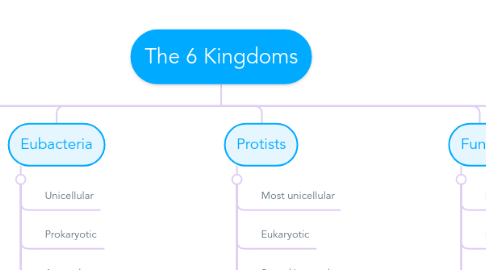The 6 Kingdoms
von Sofía Velasco


1. The Taxonomic levels of each kingdom
1.1. Domain
1.2. Kingdom
1.3. Phylum
1.4. Class
1.5. Order
1.6. Family
1.7. Genus
1.8. Species
1.9. Sub-species
2. Archaea Bacteria
2.1. Unicellular
2.2. Prokaryotic
2.3. Asexual
2.4. Contains uncommon lipids,
2.4.1. Can live in extreme conditions
2.5. Ancestors of eukaryotes
2.6. Examples
2.6.1. Methanobacteria
2.6.2. Halobacteria
2.6.3. Lokiarchaeota
3. Eubacteria
3.1. Unicellular
3.2. Prokaryotic
3.3. Asexual
3.4. Cell wall is peptidoglycan
3.4.1. Pathogenic aid in digestion
3.5. Gave rise to eukaryote organelles
3.6. Examples
3.6.1. Actinobacteria
3.6.2. Proteobacteria
3.6.3. Firmicutes
4. Protists
4.1. Most unicellular
4.2. Eukaryotic
4.3. Sexual/asexual
4.4. Cell wall is pectin or it does´t have
4.4.1. Membrane-bound organelles
4.4.2. No nucleus
4.5. First protist: eukaryotic cells.
4.6. Examples
4.6.1. Plasmodium falciparum
4.6.2. Trypanosoma brucei
4.6.3. Cystoisospora belli
5. Fungi
5.1. Most multicellular
5.2. Eukaryotic
5.3. Sexual/Asexual
5.4. Cell wall is chitin
5.4.1. They have a membrane-bound nuclei
5.4.2. No chlorophyll
5.5. They are descomposers
5.6. Examples
5.6.1. Yeast
5.6.2. Ascomycota
5.6.3. Zygomycota
6. Plants
6.1. Multicellular
6.2. Eukaryotic
6.3. Sexual/Asexual
6.4. Cell wall is cellulose
6.4.1. They all have roots
6.4.2. They are green
6.5. Give oxygen to everyone
6.6. Examples
6.6.1. Pinidae
6.6.2. Tracheophyta
6.6.3. Embryophyta
7. Animals
7.1. Multicellular
7.2. Eukaryotic
7.3. Sexual/Asexual
7.4. They lack of cell walls
7.4.1. They all move
7.4.2. Multiple cells with mythocondria
7.4.3. They have organ systems
7.5. They impact directly in every ecosystem
7.6. Examples
7.6.1. Vertebrata
7.6.2. Mollusca
7.6.3. Porifera
